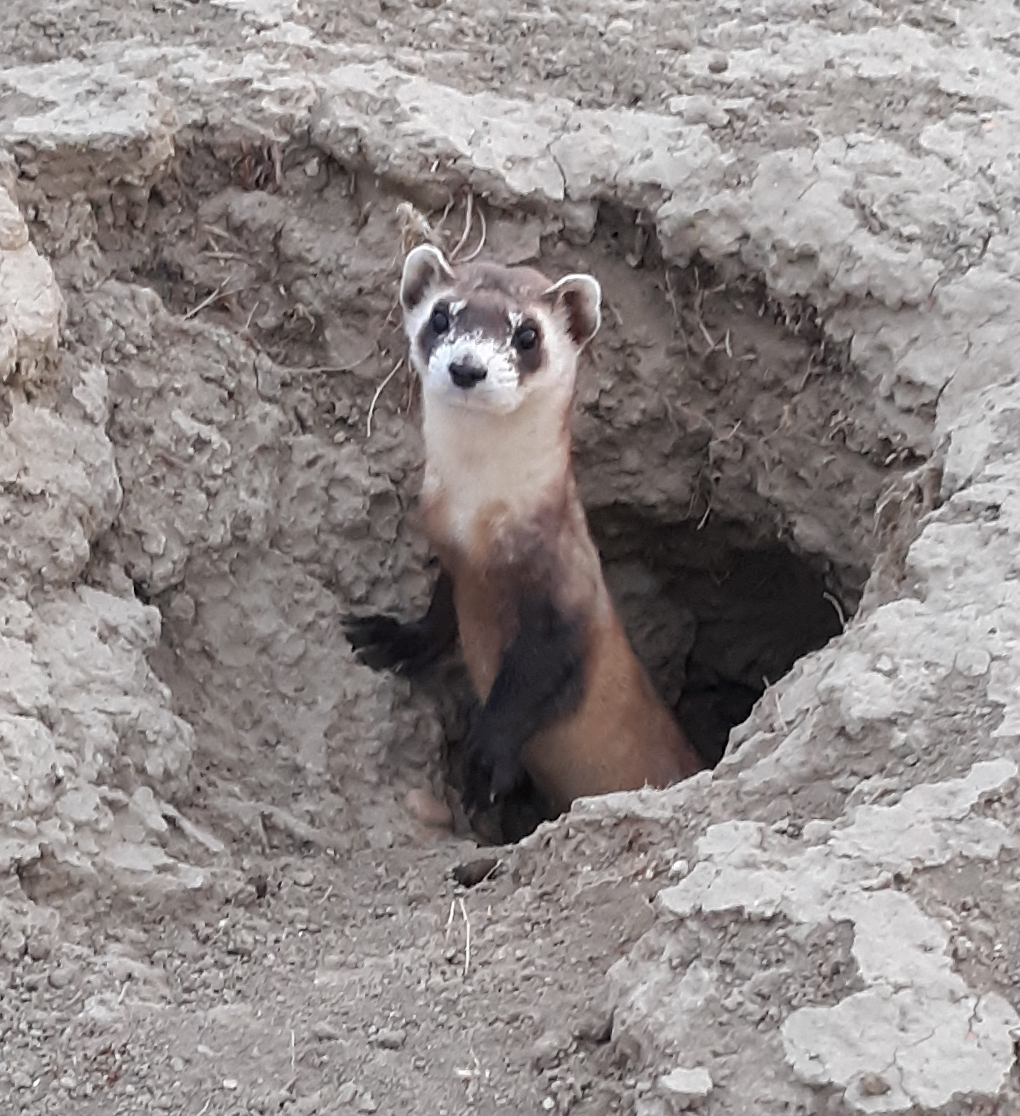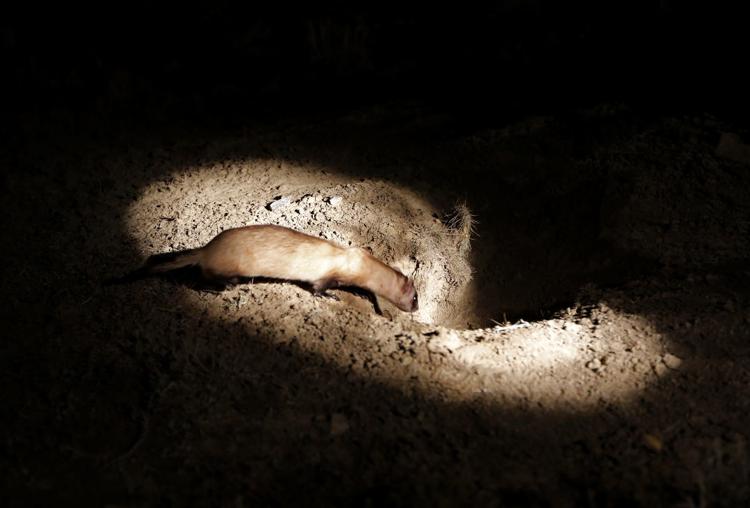Recovering one of North America's rarest mammals:
The case of the Black-footed Ferret
The case of the Black-footed Ferret
|
Masked Bandit of the Plains
The black-footed ferret (Mustela nigripes) is an highly endangered weasel species historically occurring throughout the plains and sage-brush steppe regions of North America. Current estimates by biologists suggest that less than 300 individuals exist in the wild today. Populations of this specialist predator have declined as a result of a combination of factors, including the spread of an exotic disease (sylvatic plague), and historical shooting and poisoning of prairie dogs, which provide both the primary food source and habitat needs for ferrets. Today, ferrets occur in the wild at a series of reintroduction sites where this species has been reintroduced from animals originally derived from a captive breeding program. |
An adult female black-footed ferret pears out from a prairie dog burrow. The black feet and black masked around the eyes distinguish this species from other ferret and weasels. ©SJS.
|
|
Monitoring Efforts for Black-footed Ferrets
Recovery efforts of ferrets have are challenged by a multitude of factors, one of which includes finding reliable techniques for detecting this elusive species on the landscape. Ferrets live in the underground burrow systems created by prairie dogs. Primarily nocturnal in nature, ferrets only come aboveground during infrequent and unpredictable bouts during nighttime hours. Currently, the best method for finding ferrets requires biologists to spend many nights navigating around massive colonies of prairie dog burrows with spotlighting equipment hoping to catch a rare glimpse of this mysterious weasel outside of a burrow. |
An Innovative and Elevated Solution?
SJS has partnered with a team of wildlife biologists interested in exploring how UAVs might assist the recovery of ferrets by potential serving to supplement monitoring efforts conducted by biologist across western North America. UAV systems are becoming increasingly used to detect and monitoring a wide variety of wildlife species, including other nocturnal species. For example, UAVs fitted with thermal cameras have been utilized to detect small carnivores at night at high rates. SJS began working with collaborators in 2022 to develop survey methodologies to test the effectiveness of blending UAV technology with traditional spotlight surveys and decades of ferret research to arrive at a new technique for finding ferrets at night.
During fall of 2022, we conducted 22 hours of UAV surveys for ferrets during nighttime flights and successfully detected 4 individuals. All ferrets observed by UAV were subsequently verified to species with on-the-ground spotlight surveys. This effort marks the first time black-footed ferrets have been successfully detected using UAVs equipped with thermal cameras during nighttime flights. We consider this promising result to be a critical first step toward comprehensively evaluating how UAV-based survey methods might be incorporated into ferret monitoring and management efforts. Our results suggest that UAVs could be used to efficiently detect ferrets from the air, survey large areas at reduced survey times compared to traditional methods, and overcome other challenges (i.e., difficult terrain, limited road-access) associated with on-the-ground survey methods. Additional research to develop best methods for optimizing the value of UAV-based surveys for ferrets is anticipated in the near future.
SJS has partnered with a team of wildlife biologists interested in exploring how UAVs might assist the recovery of ferrets by potential serving to supplement monitoring efforts conducted by biologist across western North America. UAV systems are becoming increasingly used to detect and monitoring a wide variety of wildlife species, including other nocturnal species. For example, UAVs fitted with thermal cameras have been utilized to detect small carnivores at night at high rates. SJS began working with collaborators in 2022 to develop survey methodologies to test the effectiveness of blending UAV technology with traditional spotlight surveys and decades of ferret research to arrive at a new technique for finding ferrets at night.
During fall of 2022, we conducted 22 hours of UAV surveys for ferrets during nighttime flights and successfully detected 4 individuals. All ferrets observed by UAV were subsequently verified to species with on-the-ground spotlight surveys. This effort marks the first time black-footed ferrets have been successfully detected using UAVs equipped with thermal cameras during nighttime flights. We consider this promising result to be a critical first step toward comprehensively evaluating how UAV-based survey methods might be incorporated into ferret monitoring and management efforts. Our results suggest that UAVs could be used to efficiently detect ferrets from the air, survey large areas at reduced survey times compared to traditional methods, and overcome other challenges (i.e., difficult terrain, limited road-access) associated with on-the-ground survey methods. Additional research to develop best methods for optimizing the value of UAV-based surveys for ferrets is anticipated in the near future.


